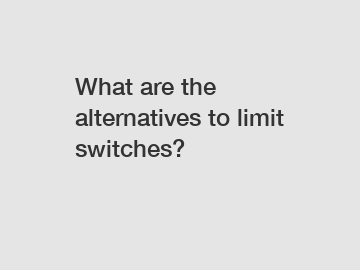What are the alternatives to limit switches?
Limit switches are commonly used in automation and industrial applications to detect the position of machinery and control its movement. However, there are situations where limit switches may not be the most suitable option. In such cases, there are alternative technologies that can be used to achieve similar results. In this article, we will explore some of the alternatives to limit switches and their applications in different industries.
Proximity Sensors.
Proximity sensors are one of the most popular alternatives to limit switches. These sensors use electromagnetic fields, capacitance, or infrared light to detect the presence of objects without physical contact. They are versatile and can be used in various applications, including detecting the presence or absence of objects, measuring distances, and sensing motion. Proximity sensors are also more reliable than limit switches as they do not have mechanical parts that can wear out over time.

Ultrasonic Sensors.
Ultrasonic sensors use sound waves to detect the distance to an object. They are non-contact sensors that are ideal for detecting objects in harsh environments or applications where physical contact is not desirable. Ultrasonic sensors are commonly used in robotics, automotive, and industrial applications where precise distance measurement is required. These sensors can be used to detect objects regardless of their shape, color, or transparency, making them versatile and reliable in a wide range of applications.
Photoelectric Sensors.
Photoelectric sensors use light beams to detect the presence or absence of objects. They are commonly used in conveyor systems, packaging machines, and material handling equipment. Photoelectric sensors are available in various types, including diffuse, retroreflective, and through-beam sensors, each suited for different applications. These sensors are easy to install, highly reliable, and can be used to detect objects in dusty, dirty, or high-temperature environments where limit switches may not be suitable.
Machine Vision Systems.
Machine vision systems use cameras and image processing software to inspect and analyze objects. These systems are highly versatile and can be used for a wide range of applications, including quality control, object detection, and motion tracking. Machine vision systems can be programmed to perform complex tasks such as measuring dimensions, counting objects, and identifying defects. While more complex and costly than limit switches, machine vision systems offer greater flexibility and can provide valuable data for process optimization and automation.
Inductive Sensors.
Inductive sensors use electromagnetic fields to detect the presence of metallic objects. These sensors are commonly used in metalworking, automotive, and manufacturing industries where detecting metal parts is essential. Inductive sensors are robust, reliable, and can operate in harsh environments with dust, dirt, or moisture. They are available in various sizes, shapes, and sensing distances, making them suitable for a wide range of applications where limit switches may not be practical.
Conclusion.
While limit switches are widely used in industrial automation, there are alternative technologies that can provide similar functionality in different applications. Proximity sensors, ultrasonic sensors, photoelectric sensors, machine vision systems, and inductive sensors offer versatile and reliable solutions for detecting objects, measuring distances, and controlling motion without physical contact. By exploring these alternatives, engineers and manufacturers can choose the right technology for their specific requirements and optimize their processes for efficiency and productivity.
Contact us for more information on alternative technologies to limit switches and how they can benefit your industrial automation applications.
If you want to learn more, please visit our website Vertical Limit Switch, Roller Lever Actuator Limit Switch Supplier, Industrial Limit Switch.
227
0
0

Comments
All Comments (0)